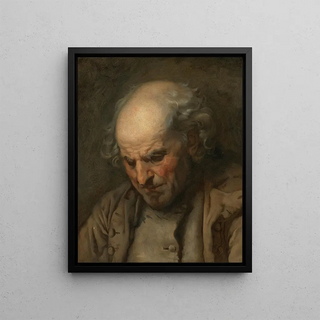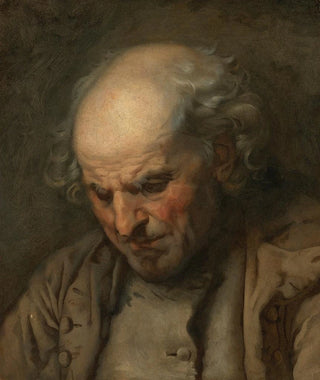Art print | Study of an old man's head and shoulders - Jean-Baptiste Greuze


View from behind

Frame (optional)
Introduction captivante
The artwork "Study of an Old Man's Head and Shoulders" by Jean-Baptiste Greuze is a masterpiece that embodies the very essence of 18th-century painting. In this study, Greuze manages to capture the depth of human experience through the wrinkled and expressive face of an old man. Every fold of his skin tells a story, and every shadow and light plays a crucial role in the visual narration. This piece, both intimate and universal, invites us to contemplate the beauty of aging and the wisdom gained over time. Immersing ourselves in this representation, we are transported to a universe where emotion and art meet, creating a timeless connection between the artist and the viewer.
Style and uniqueness of the work
Greuze's style is distinguished by its realistic approach and attention to detail. In "Study of an Old Man's Head and Shoulders," the chiaroscuro technique is employed with remarkable mastery, highlighting the features of the face while creating an atmosphere of depth and mystery. The colors, both soft and nuanced, add an extra dimension to the piece, emphasizing the texture of the skin and the brightness of the eyes. What makes this study particularly unique is the way Greuze manages to transcend the simple portrait to offer a reflection on the human condition. The old man is not just a subject but a symbol of experience, memory, and life's fragility. This ability to evoke deep emotions and provoke thought is what makes this work a true masterpiece.
The artist and his influence
Jean-Baptiste Greuze, born in 1725, is one of the most influential artists of the Rococo and pre-Romantic movement. His work, characterized by a particular sensitivity to human emotions, marked a break with the academic conventions of his time. Greuze succeeded in establishing himself through his ability to depict scenes of everyday life with rare emotional intensity. His portraits, especially those of children and the elderly, reveal a profound understanding of the

Matte finish

View from behind

Frame (optional)
Introduction captivante
The artwork "Study of an Old Man's Head and Shoulders" by Jean-Baptiste Greuze is a masterpiece that embodies the very essence of 18th-century painting. In this study, Greuze manages to capture the depth of human experience through the wrinkled and expressive face of an old man. Every fold of his skin tells a story, and every shadow and light plays a crucial role in the visual narration. This piece, both intimate and universal, invites us to contemplate the beauty of aging and the wisdom gained over time. Immersing ourselves in this representation, we are transported to a universe where emotion and art meet, creating a timeless connection between the artist and the viewer.
Style and uniqueness of the work
Greuze's style is distinguished by its realistic approach and attention to detail. In "Study of an Old Man's Head and Shoulders," the chiaroscuro technique is employed with remarkable mastery, highlighting the features of the face while creating an atmosphere of depth and mystery. The colors, both soft and nuanced, add an extra dimension to the piece, emphasizing the texture of the skin and the brightness of the eyes. What makes this study particularly unique is the way Greuze manages to transcend the simple portrait to offer a reflection on the human condition. The old man is not just a subject but a symbol of experience, memory, and life's fragility. This ability to evoke deep emotions and provoke thought is what makes this work a true masterpiece.
The artist and his influence
Jean-Baptiste Greuze, born in 1725, is one of the most influential artists of the Rococo and pre-Romantic movement. His work, characterized by a particular sensitivity to human emotions, marked a break with the academic conventions of his time. Greuze succeeded in establishing himself through his ability to depict scenes of everyday life with rare emotional intensity. His portraits, especially those of children and the elderly, reveal a profound understanding of the






